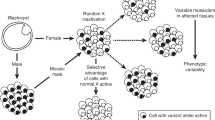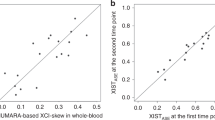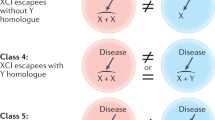Abstract
ALTHOUGH women are known to be more viable than men, the biological mechanisms for this difference are poorly understood. A relevant question is, to what extent does heterozygosity for X-linked loci contribute to survival of the XX female? The advantage accruing to the XX female through having this factor can be defined as X-heterosis1. Practically all serious X-linked disorders such as haemophilia occur in males, but the total incidence of such severe diseases is relatively small and cannot account for the observed sex differences in age specific mortality rates. It is conceivable that X-heterosis is relatively insignificant in the total population, and that the bulk of the observed sex difference is attributable to physiological factors that are a consequence of sex differentiation (for example, the apparent oestrogen-sparing effect on coronary heart disease) and/or to psycho-cultural factors that may pertain to diminished exposure of women to environmental hazards (for example, industrial pollutants).
This is a preview of subscription content, access via your institution
Access options
Subscribe to this journal
Receive 51 print issues and online access
$199.00 per year
only $3.90 per issue
Buy this article
- Purchase on Springer Link
- Instant access to full article PDF
Prices may be subject to local taxes which are calculated during checkout
Similar content being viewed by others
References
Hook, E. B., Amer. J. Hum. Genet., 21, 290 (1969).
Jackson, C. E., Mann, J. D., and Schull, W. J., Nature, 222, 445 (1969).
Schull, W. J., Amer. J. Hum. Genet., 10, 294 (1958).
Schull, W. J., and Neel, J. V., Amer. J. Hum. Genet., 15, 106 (1963).
Schull, W. J., Komatsu, I., Nagano, H., and Yamamoto, M., Proc. US Nat. Acad. Sci., 59, 671 (1968).
Schull, W. J., Furusho, J., Yamamoto, M., Nagano, H., and Komatsu, I., Humangenetik, 9, 294 (1970).
Schull, W. J., Nagano, H., Yamamoto, M., and Kamatsu, I., Amer. J. Hum. Genet., 22, 239 (1970).
Taeuber, I., The Population of Japan (Princeton University Press, 1958).
Author information
Authors and Affiliations
Rights and permissions
About this article
Cite this article
HOOK, E., SCHULL, W. Why is the XX Fitter? Evidence Consistent with an Effect of X-heterosis in Women from Sex Ratio Data in Offspring of First Cousin Marriages. Nature 244, 43–46 (1973). https://doi.org/10.1038/244043a0
Received:
Revised:
Issue Date:
DOI: https://doi.org/10.1038/244043a0
This article is cited by
-
Chromosome imprinting and the mammalian X chromosome
Nature (1975)
Comments
By submitting a comment you agree to abide by our Terms and Community Guidelines. If you find something abusive or that does not comply with our terms or guidelines please flag it as inappropriate.



